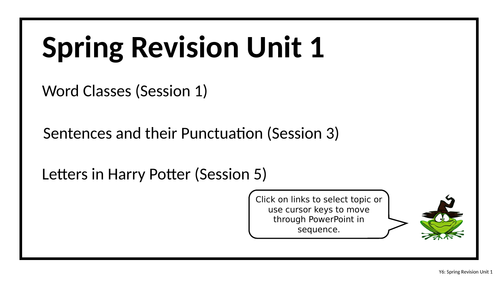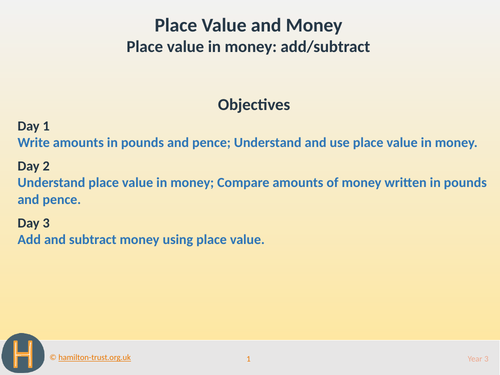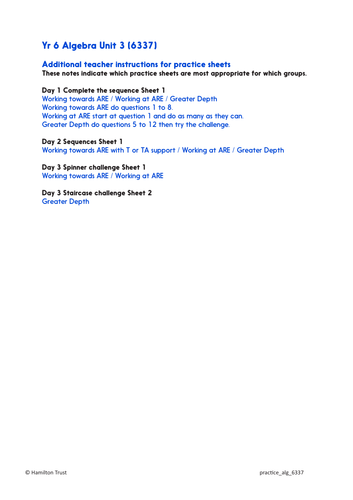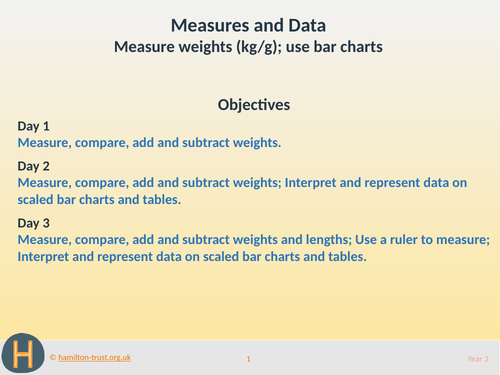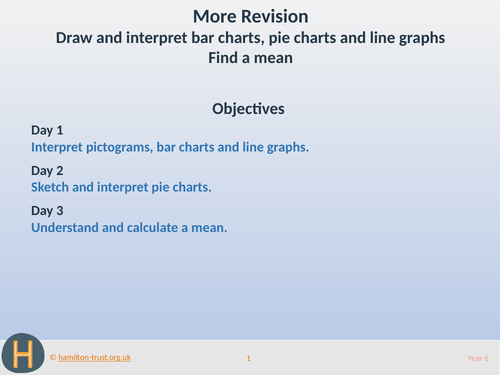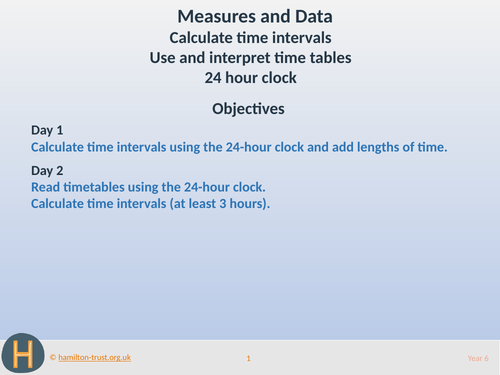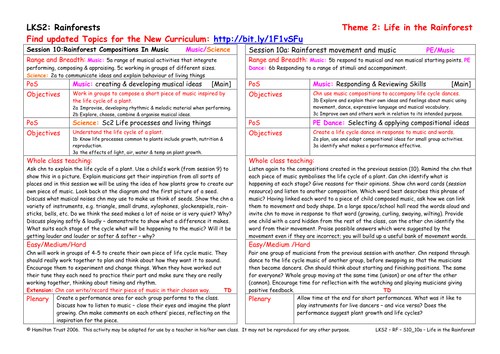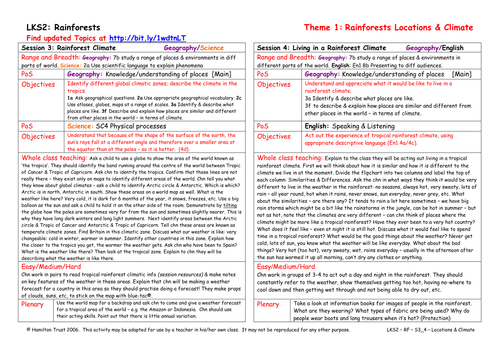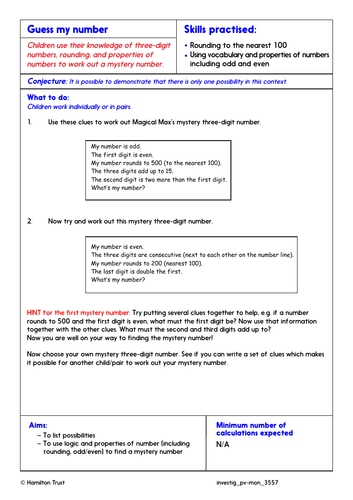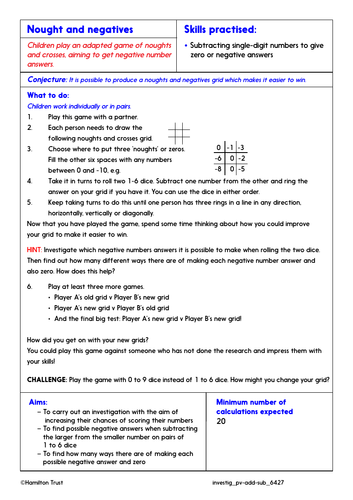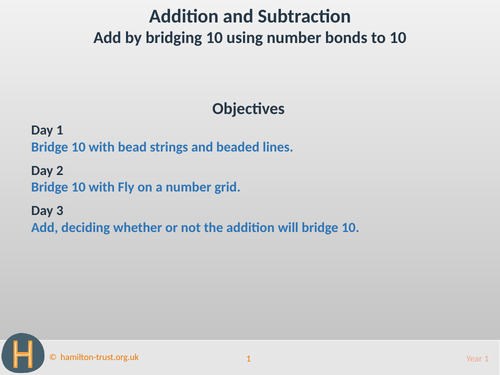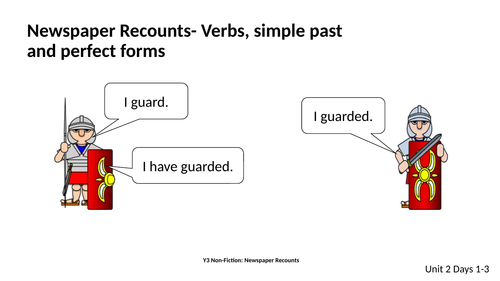
3k+Uploads
9968k+Views
11582k+Downloads

Teaching Presentation: Place value in money: add/subtract. (Year 3 Place Value and Money)
This presentation provides three days of teaching that cover the objectives:
Develop understanding of place value in money.
Use to add and subtract.
It includes starter activities, whole class teaching, group activities, practice sheets and mastery questions. It can be used on a variety of interactive whiteboards.
Day 1 Teaching
Show 3 large pound coins, a 50p coin and a 2p coin (or IWB coins). How much money is here? How can we write it? Revise how we write this as £3.52. Rehearse writing amounts of money.
Day 2 Teaching
Display the Money place value grid (see resources). Remind children how to write amounts in £ and p. Write amounts including those containing 0 on the PV grid. Compare the amounts using symbols.
Day 3 Teaching
Play the ‘Nasty Game’ and record place value additions such as £2 + 30p + 5p, £2.05 + 30p, etc. Check all possibilities. Ensure children are confident in writing amounts such as £2.05 and do not write this as £2.5. Ask children to write subtraction sentences for same amount.
This teaching is part of Hamilton’s Year 3 Place Value and Money block. Each Hamilton maths block contains a complete set of planning and resources to teach a term’s worth of objectives for one of the National Curriculum for England’s maths areas.
Bundle

Year 3 Fractions - Problem-Solving Investigations
These in-depth maths investigations are open-ended problem solving activities for Year 3 children.
In-depth Investigation: Fraction Clues
Children use their knowledge of fractions and tables to find mystery numbers.
In-depth Investigation: Fraction Bets
Children look at fractions and make a hypothesis of which ones are closest. They then test this out by placing fractions on a line.
In-depth Investigation: Greedy Guzzler
Children explore which is the greater fraction of a set amount. They also fold strips to look at the fractions.
These investigations will develop maths meta-skills, support open-ended questioning and logical reasoning, and enable children to learn to think mathematically and articulate mathematical ideas.
These problem-solving investigations come from our Year 3 Maths Blocks. Each Hamilton maths block contains a complete set of planning and resources to teach a term’s worth of objectives for one of the National Curriculum for England’s maths areas.

Practice Worksheets: Generate and continue linear sequences. (Year 6 Algebra)
Year 6 Algebra: Generate and continue linear sequences.
Procedural fluency practice Worksheets to achieve maths mastery. Differentiated for children working towards Age Related Expectations (ARE), at ARE and at greater depth.
Day 1 - Work out the step increase/decrease in sequences in order to complete them. Sequences include those which pass through zero, and which increase/decrease by numbers with 1 decimal place.
Day 2 - Children work in pairs to find the 10th, 100th then nth term for sequences.
Day 3 - Draw the next spinner/staircase in a sequence. Find a relationship between the number of shapes in the
spinner/staircase and its position in the sequence.
These procedural fluency practice sheets are part of our Year 6 Algebra block. Each Hamilton maths block contains a complete set of planning and resources to teach a terms worth of objectives for one of the National Curriculum for England’s maths areas.

Measure weights in g and kg - Teaching Presentation - Year 3
This presentation provides three days of teaching that cover the objectives:
Measure weights in g and kg
Use bar charts
It includes starter activities, whole class teaching, group activities, practice sheets and mastery questions. It can be used on a variety of interactive whiteboards.
Day 1 Teaching
Pass round a 1Kg bag of flour, and then a Kg weight so that children can feel how heavy this is. Then have 2 hoops (<1Kg and >1Kg) and pass objects round the circle. When music stops children place object in correct hoop.
Day 2 Teaching
Have a 1kg bag of flour and a 100g apple. Children pass round different objects and estimate their weights in relation to flour and apples. Use data to create a bar chart.
Day 3 Teaching
Children collect, record and interpret own data. Think of ideas of data they might be able to collect, e.g. Who has the longest index finger? Which is the longest leaf out of a collection? Who has the heaviest lunchbox? Etc.
This teaching is part of Hamilton’s Year 3 Measures and Data block. Each Hamilton maths block contains a complete set of planning and resources to teach a term’s worth of objectives for one of the National Curriculum for England’s maths areas.

Bar charts, pie charts, line graphs, means - Teaching Presentation - Year 6
This presentation provides three days of teaching that cover the objectives:
Interpret pictograms, bar charts and line graphs.
Sketch and interpret pie charts.
Understand and calculate a mean.
It includes starter activities, whole class teaching, group activities, practice sheets and mastery questions. It can be used on a variety of interactive whiteboards.
Day 1 Teaching
Show and explain the graph of pets. How many children chose a rabbit? Discuss the scale of the graph. Draw a line down to the horizontal axis, and label it 50. Repeat with similar questions. Share today’s top tip. Show a line graph of a dog’s growth in weight over time and ask questions, including intermediate points.
Day 2 Teaching
Show children the graph of pets from day 1. Label each bar with the numbers: 50, 150 and 100. How many children were surveyed in total? 50 out of 300 children chose a rabbit, what fraction is this? (1/6). What fraction chose a dog? (1/2). What fraction chose a cat? (1/3). Children sketch a pie chart to show the results.
Day 3 Teaching
Remind children what the word average means and how the mean is one type of average. A sprinter ran 100m in times of 12s, 15s, 13s, and 16s; then calculated her mean time to be 18s. Does this sound right? Share today’s top tip for tests. Children add the 4 times together and divide by 4 to find her mean time. Take feedback. Challenge children to write three different numbers with a mean of 10.
This teaching is part of Hamilton’s Year 6 More Revision block. Each Hamilton maths block contains a complete set of planning and resources to teach a term’s worth of objectives for one of the National Curriculum for England’s maths areas

Time intervals, timetables, 24-hour clock - Teaching Presentation - Year 6
This presentation provides two days of teaching that cover the objectives:
Calculate time intervals
Use and interpret time tables
24 hour clock
It includes starter activities, whole class teaching, group activities, practice sheets and mastery questions. It can be used on a variety of interactive whiteboards.
Day 1 Teaching
Revise the 24-hour clock, converting from am and pm times to the 24-hour clock. Find differences between times that children have written, demonstrating how to count up along a time line.
Day 2 Teaching
Display the timetable of trains from Thurso (see resources). Discuss how we can work out how long particular parts of the journey take. Count up to calculate time intervals.
This teaching is part of Hamilton’s Year 6 Measures and Data block. Each Hamilton maths block contains a complete set of planning and resources to teach a term’s worth of objectives for one of the National Curriculum for England’s maths areas.

Devices to build cohesion - Presentation & Exercises
Grammar teaching presentation and grammar exercises.
The teaching presentation includes 22 slides that cover:
Devices to build cohesion within and across paragraphs.
Pronouns
Determiners
Subordinating Conjunctions
Adverbs
Paragraphs
Adverbials (including place, number, time)
Topic Sentences
Each cohesive device is introduced, clearly explained, and an example is provided. The class is asked some simple questions to check understanding.
We then provide grammar exercises for children to:
Practise using conjunctions correctly
Practise using cohesive devices within a paragraph
Each collection of exercises is made up of three sets. Set A is the easiest or most accessible, Set C is the hardest or uses more complex language.
This resource is aimed at UKS2. Use the presentation to introduce or revise a grammatical concept as a stand-alone lesson or add on the accompanying exercises for children to practise and apply their knowledge.

Family Food
Consider where the food that we eat comes from. Grown at home, locally or in another country? Discuss food miles. Who does the shopping, cooking, washing up? Where does the water come from? Cook a meal/dish and write the recipe to send to your link school. Suitable for years 5 and 6.

Rainforest Compositions In Music
Using what they have found out about plant life cycles children work in small groups to create a life cycle musical composition. Thinking about instrument choice and dynamics, children respond to the music asking how well does it represents the life cycle?
Suitable for years 3 and 4.
Find other lesson plans and resources at www.hamilton-trust.org.uk.

Living In A Rainforest Climate
What would life be like if you lived in a rainforest? Children compare our climate to that in the rainforests – it’s very different! Children act out a rainforest scene to show how they would try to cope with the climate.
Suitable for years 3 and 4.
Find other lesson plans and resources at www.hamilton-trust.org.uk.

Use modal verbs and adverbs to indicate degrees of possibility - Year 5 SPAG
Learn how modal verbs modify verbs to indicate possibility, ability or obligation. Look at how modal verbs can be used to express shades of meaning.
SPAG resources that cover the following grammar objectives:
– Use modal verbs or adverbs to indicate degrees of possibility
Included in this unit:
Up to 3 days of teaching.
Presentation that can be used on a variety of interactive whiteboards.
Group activity resources.
This SPAG Unit is part of a larger block on Kensuke’s Kingdom.
Find additional teaching on Hamilton’s Year 5 English Block about Kensuke’s Kingdom.

Conjunctions and adverbs for cohesion (Presentation & Exercises) - Year 5 SPAG
Revise conjunctions and adverbs, exploring their role in cohesion and persuasion and the different ways they function in joining and linking clauses.
SPAG resources that cover the following grammar objectives:
– Use devices to build cohesion within a paragraph [conjunctions & adverbs].
– Use and understand the grammatical terminology in English Appendix 2 accurately and appropriately in discussing their writing and reading.
Included in this unit:
Up to 3 days of teaching.
Presentation that can be used on a variety of interactive whiteboards.
Group activity resources.
This SPAG Unit is part of a larger block on Persuasion and Argument.
Find additional teaching on Hamilton’s Year 5 English Block about Persuasion and Argument.

Write dialogue using correct punctuation and a variety of reporting clauses - Year 4 SPAG
Writing and Punctuating Dialogue PowerPoint
Teach children how to write dialogue, adding the reporting clause at the start, in the middle or at the end of the speech. Rehearse end of sentence punctuation.
SPAG resources that cover the following grammar objectives:
– Use and punctuate direct speech.
Included in this unit:
Up to 3 days of teaching.
Presentation that can be used on a variety of interactive whiteboards.
Group activity resources.
This SPAG Unit is part of a larger block on Reports - Narratives of Liberation.
Find additional teaching on Hamilton’s Year 4 English Block about Reports - Narratives of Liberation.

Represent 3-digit numbers in diff ways - Problem-Solving Investigation - Year 3
Year 3 Place Value and Money: Represent 3-digit numbers in many different ways; round numbers to 10 and 100.
This in-depth maths investigation will develop maths meta-skills, and enable children to learn to think mathematically and articulate mathematical ideas.
In-depth Investigation: Guess my Number
Children use their knowledge of 3-digit numbers, rounding, and properties of numbers to work out a mystery number.
This problem-solving investigation is part of our Year 3 Place Value and Money block. Each Hamilton maths block contains a complete set of planning and resources to teach a term’s worth of objectives for one of the National Curriculum for England’s maths areas.

Add numbers with up to 3 decimal places - Problem-Solving Investigation - Year 6
This in-depth maths investigation is an open-ended problem solving activity for Year 6 children. It can be used to support teaching towards objective: Add numbers with up to three decimal places.
In-depth Investigation: Decimal Pyramids
Children add numbers with 3 decimal places to give a number with 2 decimal places. They add numbers with 2 decimal places to give a number with 1 decimal place. They then add numbers with 1 decimal place to give a whole number.
This investigation will develop maths meta-skills, support open-ended questioning and logical reasoning, and enable children to learn to think mathematically and articulate mathematical ideas.
This problem-solving investigation is part of our Year 6 Decimals and Fractions block. Each Hamilton maths block contains a complete set of planning and resources to teach a term’s worth of objectives for one of the National Curriculum for England’s maths areas.

Understand/calculate negative numbers - Problem-Solving Investigation - Year 6
This in-depth maths investigation is an open-ended problem solving activity for Year 6 children. It can be used to support teaching towards the place value, addition and subtraction objectives: understand negative numbers and perform calculations across 0.
In-depth Investigation: Noughts and Negatives
Children play an adapted game of noughts and crosses, aiming to get negative number answers.
This investigation will develop maths meta-skills, support open-ended questioning and logical reasoning, and enable children to learn to think mathematically and articulate mathematical ideas.
This problem-solving investigation is part of our Year 6 Place Value, Addition and Subtraction block. Each Hamilton maths block contains a complete set of planning and resources to teach a term’s worth of objectives for one of the National Curriculum for England’s maths areas.
Bundle

Complete Revision for SATs - Harry Potter-themed Revision Plans
Make your Y6 Spring Revision Term children’s best term ever!
Revise all necessary grammar, punctuation and spelling for the Year 6 SPAG tests, as well as reading, comprehension and writing objectives within an inspirational term’s work that follows the sequence of Harry Potter and the Philosopher’s Stone.
You can teach it all, or pick and mix. The 5-minute grammar revision sessions, for example, work brilliantly as stand-alone teaching elements.
This Year 6 English revision block is designed to provide a truly inspirational term’s work. It is divided into eight themed units that guarantee an exciting and stimulating literary experience, as well as covering all necessary revision, including the grammar, punctuation and spelling for the SPAG tests as well as reading, comprehension and writing. Units 1-5 follow the sequence of Harry Potter and the Philosopher’s Stone, allowing the class to read the book alongside the teaching. The final units (6-8) select some of the best bits from the rest of the series, whilst avoiding spoilers.
Finish off the term with a mock test and a celebration!
You can also access this Harry Potter themed revision block on the Hamilton website.

Add by bridging 10 using number bonds to 10 - Teaching Presentation - Year 1
This presentation provides three days of teaching that cover the objectives:
Bridge 10 with bead strings and beaded lines.
Bridge 10 with Fly on a number grid.
Add, deciding whether or not the addition will bridge 10.
It includes starter activities, whole class teaching, group activities, practice sheets and mastery questions. It can be used on a variety of interactive whiteboards.
Day 1 Teaching
Show children the bead bar. Slide 8 beads to one side. Model adding 3 by sliding 2 beads to make 10, then 1 more. Repeat to show 7 add 5 by adding 3 to make 10 and then adding 2 more beads. When we add in two steps like this, stopping at 10, we call it bridging 10. Repeat, to find 8 + 5, 6 + 5 and 9 + 6, bridging 10 on the bead bar, with children replicating on bead strings.
Day 2 Teaching
Show children a 1-100 number grid and Fly. Remind them that Fly can make a short flight to the next 10 from any number. Demonstrate adding 5 to 25 using Fly. Then model adding 5 to 17, using Fly to go to 20 first, and then counting on 2 more. Record: 17 + 5 = 22. Do you see how we bridged 20, a 10s number? Repeat for 28 + 6 and 36 + 5.
Day 3 Teaching
Use a 100 bead bar to show children 36 + 5, an addition bridging 10. Then discuss how we can recognise if an addition will need to cross a 10s number. Repeat for 57 + 4 and 35 + 7. Model drawing hops for 35 + 7 on a beaded line.
This teaching is part of Hamilton’s Year 1 More Addition and Subtraction block. Each Hamilton maths block contains a complete set of planning and resources to teach a term’s worth of objectives for one of the National Curriculum for England’s maths areas.

Problem-Solving Investigation: Understanding and identifying 2-D shapes (Year 1 Shape and Data)
Year 1 Shape and Data: Understanding and identifying 2-D shapes
This in-depth Maths Investigation will develop maths meta-skills, and enable children to learn to think mathematically and articulate mathematical ideas.
In-depth Investigation: Shape Wheels
Children make a sequence of coloured shapes, changing one attribute at a time so that the sequence can end where it started, forming a circular sequence.
This problem-solving investigation is part of our Year 1 Shape and Data block. Each Hamilton maths block contains a complete set of planning and resources to teach a terms worth of objectives for one of the National Curriculum for England’s maths areas.

Verb tense, perfect form and role-play (Presentation & Exercises) - Year 3 SPAG
Presentation and practice exercises to teach children about verbs, noting what defines an active verb. Explain tense, and introduce present, simple past, then present perfect form.
SPAG resources that cover the following grammar objectives:
– Use the present perfect form of verbs in contrast to the past tense
(Revise simple past and present verb forms)
Included in this unit:
Up to three days of teaching
Presentation that can be used on a variety of interactive whiteboards.
Group activity resources.
This SPAG Unit is part of a larger block on Newspaper Recounts.
Find additional teaching on Hamilton’s Year 3 English Block about Newspaper Recounts.

